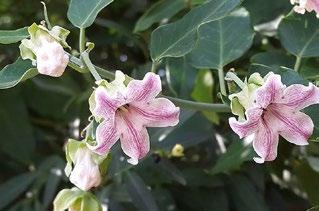
2 minute read
April Webb
Plant Alert – March 2021 update
Spring has finally sprung, marking the beginning of another Plant Alert season. By the time this has reached you, we will have just finished our first event of 2021, a presentation covering the challenges of finding the future’s invasive plants, hosted by the Field Studies Council as part of their Natural History Live virtual sessions.
Advertisement
In the darker months, we began cleaning the Plant Alert dataset, in particular verifying records from photos submitted and removing those that were not from inside gardens. Probably encouraged through our media campaign and illustration of newspaper articles with well-known invasives such as Japanese Knotweed and Himalayan Balsam, a number of people reported these species from their local area, but not from inside of gardens. The removal of these records will, of course, change our list of top reported species, and we hope, further highlight other ornamentals potentially making the initial leap out of gardens.
Up to March 2021, we have now received 488 records with 191 unique species recorded. Of those records, Phaenosperma globosa (Waterfall Millet) and Araujia sericifera (Cruel Plant) are of a number of species yet to be recorded on the BSBI database outside of gardens. Phaenosperma globosa is a clumpforming evergreen grass spreading by stolons. The attractive flowerheads grow to around 120cm tall and develop into arching sprays of bead-like seeds. Although not currently readily available, it is becoming more popular as an architectural plant, meaning it is a species to keep an eye on.
Araujia sericifera is a twining, fast-growing, evergreen climber in the Apocynaceae, producing small sprays of bell-shaped, scented, white or pink flowers in late summer to autumn. Preferring a sheltered position, it will be one to watch in courtyard gardens and urban microclimates. A native of South America, it is listed as an invasive species in parts of Australia, South Africa and North America and also known from several southern European countries.
If either of these species is growing in a garden near you, we would appreciate further records of their behaviour. Those who have already sent in records of dominating ornamentals in the garden may be pleased to hear Plant Alert data is currently being used to help update the list of recommended species for horticulturalists for ‘non-invasive gardening’ plant choices. ‘A guide to plants you can use in place of invasive non-natives’ encompasses three booklets covering aquatics, landscaping and home gardening plant choices of those less likely to cause problems to the environment should they escape from the garden.
With the growing season underway, nurseries and garden centres are full to bursting with over 80,000 ornamental plants (RHS Plant Finder 2020) for us to choose from. Help us by spreading the word on Plant Alert to enable gardeners to report those plants spreading to an extent that they have to be controlled to prevent them overgrowing other plants or parts of the garden where they are not wanted.
To keep abreast of Plant Alert events and records find us on Twitter @Plant_Alert or our website
April Webb
support@plantalert.org
www.plantalert.org
Araujia sericifera, Johannesburg, South Africa. Paul Venter (creativecommons.org/licenses/by-sa/3.0)









